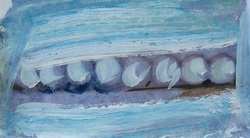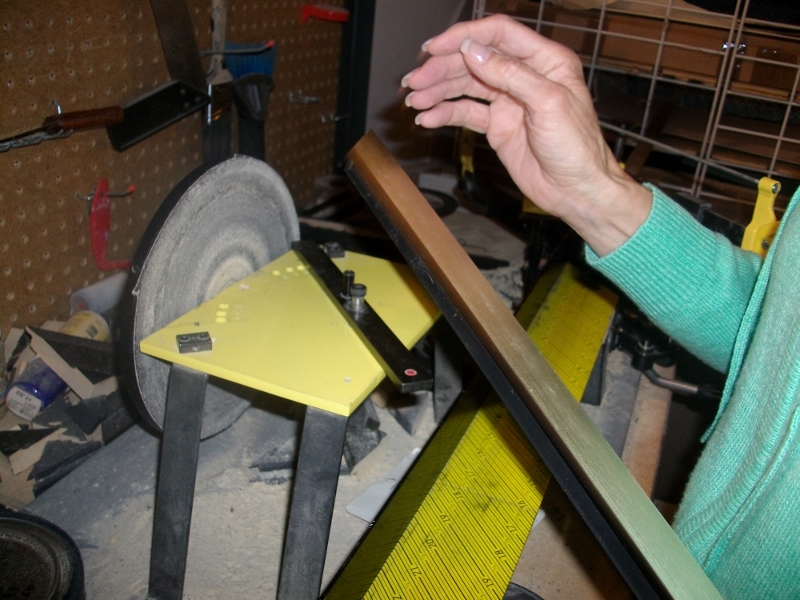 I started this a while back and am reminded to finish it by the recent opening of the Clarington Museums exhibition Rediscovering Identity: The Power of Photography. This is a multi dimensional exhibit that allows visitors to explore many facets of the medium, its mechanics as well as its history. Local artists were asked to interpret a photograph from the archives, so several IRIS members jumped at the chance to do some portraiture and I chose a photograph of what I assume to be two sisters, dressed to the nines and looking a little nonplussed. Special guest speaker at the opening was Steven Frank, who spoke about the history of photography, and showed some 19C - early 20C artifacts such as a stereoscope, wonderful leather bound album, and postcard book. Photographer Jean Michel Komarnicki recently commented that it isn't a photograph until it's printed, and that got me thinking about our existences within Walter Benjamin's famous age of mechanical reproduction. We are rapidly moving out of this era as the evanescent digital age overtakes us, and as the majority of images that we capture never become hard copy. As JMK pointed out, technological changes as well as material degradation of discs may make digital records unreadable in time. And how about those rapidly fading colour prints from the 1960s? Artists are still, of course creating photographs, mostly printed digitally, but with archival considerations. But the family photos that record so much of daily life, special events, travels etc. are mostly shown on screens rather that stored in albums. It is noteworthy, as Frank mentioned, that when disaster destroys peoples' homes the victims invariably mention the loss of those family albums. They tell the stories of our lives and become the stories that are remembered. But they are going. The earliest extant photograph is believed to be "View from the Window at Le Gras" by Nicéphore Niépce in 1826 or 1827. So figuring that by 2025 or so there won't be any more family albums, we can look at this two hundred year period as the age of the photograph. While the latter 20th century will have the richest repository of printed memories, it is possible to look at pictures taken before 1900 and gain a sense of how people dressed, celebrated, wanted themselves to be recorded. Those long exposure times invite an equally long examination of the images. Will future generations have this privilege?
1 Comment
Toni Hamel: The lingering 14 September - 24 November 2013 at The Robert McLaughlin Gallery, Oshawa Canada Given a long run and two galleries at RMG suggests the importance that the curators attribute to this artist and the thematic direction of her work. Hamel's graphically strong drawings and installations present a forceful narrative on the complications of domestic life in general as well as the psychologically repressive nature of carrying out artistic endeavours on the home front. While this is a feminist story told many times, the necessity for retelling still exists. Hamel delivers a powerful , highly skilled discourse, with content that avoids polemic with dark, subtle humour. The hand of the artist is present, as is the idea of women working with their hands. So-called housewifely tasks are shown in bizarre parody, as images of 1950s style "homemakers" carry out various housekeeping duties that subvert notions of domesticity and underscore its often constricting nature. Women's hands are at work building a nest, decorating an enormous peacock then cheerfully taking it to market in a wheelbarrow, digging in the garden for hearts, working on a child's costume, slicing bread, and so on. Women are shown working together, looking out into a larger world to which there is only imaginary access. Thread and twine are employed throughout, providing a fitting metaphor for gendered constraints. It is also used to extend, accentuate, enhance the finely detailed figurative work on paper and canvas, to define/confine the walls from which one thousand cranes fly forth, to make a cascade of hair that a woman irons industriously, or suggest the skeletal structure of wings that release a kitchen chair from its base where so much domestic work is done. The iconic house image appears in thread in small drawings such as "Attachments" where a woman mows an imaginary lawn, her machine's cord umbilically attached to the house. In other works the thread is a line pulled out of one picture plane into another. In a drawing of a photograph of a woman hanging clothes on a line, a passing bird pulls the clothesline beyond the photo into a freer space. Less whimsically, red thread sews shut a woman's mouth. While the main floor Alexandra Luke Gallery showcases the artist's exquisitely drawn wall works and three major canvas installations, an ascent to the upper gallery immerses one in a world of origami cranes escaping from six houses, into a central nest-like construction made from twigs. An accompanying sound piece of bird cries, gentle whistling, soft giggles, and a beautiful Chopin Nocturne (#9) permeates both exhibition spaces. (audio by Peter Nelis) There is unabashed femininity expressed in the aural and visual content, underscoring the multi-faceted nature of femaleness and of feminism. In general there is a tendency for us to engage in a cognitive dissonance about the role of women within the domestic sphere. There is a comfort level in homemaking that ignores the toll which it has taken in limiting women's lives. Some feminist theory re-evaluates the hand work of women as integral to oral narrative, as safe spaces for discussions, for storytelling, for continuation of a particular cultural environment, for sharing skills, ideas inside a private sphere. However it is clear from the surreal nature of many of the tasks being done by these smiling, busy women that Hamel's intent is to question the validity of repetitive and often meaningless work or, at least, work that is done at the expense of women having richer more creative lives. In her book of essays titled SILENCES, author Tillie Olson mourns the silences‑‑ the literary works unwritten or unpublished because of difficult circumstances and biased ... practices. In The lingering Hamel illustrates the issue with biting humour, skill and warmth.  Creativity is a much bandied word - the Creative Economy, creative dance, creative accounting, how-to-books on enhancing creativity, and so on. At every turn we are exhorted to be creative, and if you are working in so called creative fields there are inspirational pushes and prods available, as well as examples of how famously creative people managed to do their work. But actually there's the operative word -- work. Getting down to it. Making time even when there isn't inspiration at hand. There are always great ideas floating around but most of them can only be realized through a committed, focused and determined application of whatever talents or other means one has available. Can there be creativity without focus? I look around my studio at remnants of many writing and visual art projects, ideas explored and then sent to the back burner, pieces from past exhibitions and future ones. Research materials, books, books and more books. The bulletin board in front of my computer contains -- family photos -- a Bad Girls Book Club postcard and a group pic of the group that I belong to --a yellowing article on "How to recover accidentally deleted files" --a phone list for IRIS members --a quote from Atwood's Journals of Susanna Moodie on an old recipe card. It says: in this area where my damaged knowing of the language means prediction is forever impossible -- A sign that says RADICALUNCERTAINTY and another with inhale/exhale. Both are seasons greetings from Lynn and Ric. --Some health appointment cards, hopefully for the future, although I did miss one of them. --Quite a nice invitation from RMG for something that took place last September. And that's the top layer. Whether all of it inspires creativity is questionable.  Back from the north country, upstate New York in the Adirondacks at Saranac Lake. I am participating in an exhibition inspired by an old piano that weathered away outside the art centre. I watched it get more and more interesting over many visits to this wonderful place, as did several others who are exhibiting in this group show. Participating artists are John LaFalce, Larry Poole, Tom Lascell, Eleanor Sweeny and me, with printmaking, photography, sculpture, and manipulated photo transfers. My work is mixed media on canvas. BluSeed is an artist's dream, with concerts, gallery exhibitions, studios for a variety of art practices, and residency programs. There is an innovative papermaking studio that is holding an exchange with artists from Mexico. Once a few years ago they had artists making paper from military fatigues. I was lucky to have Jan Prebble from IRIS as a travelling companion. The six-hour drive to Saranac takes us near Fort Drum and through many little towns. There is both a sense of woodsy remoteness and also the military presence with its economic benefits. This is beautiful rugged country, and always exciting to me when we climb and climb until we are seeing mountains, and then eventually, over a hill and down into the village itself, once deemed the best little small town in America. Once famous as a treatment centre for tuberculosis, its recent claim to fame was when the residents raised money to open their own department store in order to buy basic things locally. The sense of community here is palpable, and BluSeed appears to be integral to this. As luck would have it, one of the frames I had ordered was the wrong size (my fault)'. But Jan rolled up her sleeves, determined to make me another one, and after some BluSeed help, I had a frame! This so far beyond my abilities or expectations that I was blown away. 17/02/2013 4:13 PM
Today I read a quote from Joan Didion on Twitter. It was about keeping a journal and this reminded me that it is a very good idea. Not that there are many pithy thoughts. I planned to do this in my black sketchbook in order to be able to include drawings as well. However writing on a keyboard seems to be the conduit for my voice now. I have been conditioned. Anyway I find that my handwriting is too hard to read, even by me. Within a couple of hours I have had two conversations with 2 different artists about curatorial issues. Essentially, why bother sending out exhibition packages when the small gallery system basically already has a roster and the curators do the inviting. Also given the economics, shows travel from gallery to gallery, a way to cobble together enough money for a catalogue, but also limiting opportunities for artists overall. Many wonder whether the packages that have been so carefully prepared ever get looked at. Everyone is overworked and with limited funds. Having been in both positions I can say that I did look at all of the proposals that came in. That said, it was a small institution and I wasn’t swamped with them. And as an artist I have experienced many thank you but no thanks letters that did eventually come, if perhaps a year or two after the fact. Some artists make a job of regularly sending out submissions and perhaps this makes a good squeaky wheel. hmmm |
Archives
February 2024
|
Margaret Rodgers | Canada





 RSS Feed
RSS Feed